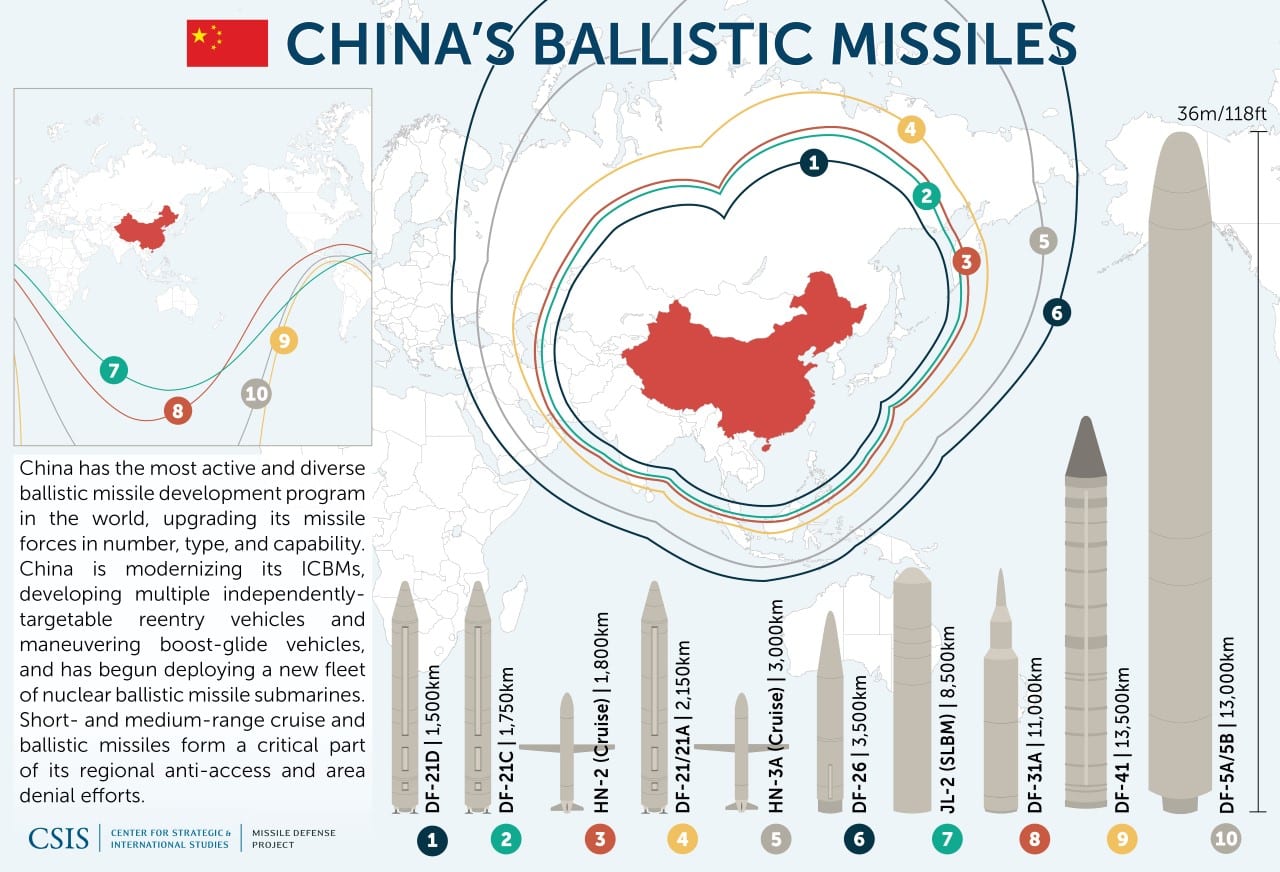U.S. Military's Strategic Shift: A New Missile System To Deter China

Table of Contents
The Growing Threat from China's Military Modernization
China's assertive military modernization poses a considerable challenge to the existing regional balance of power. This expansion is multifaceted, encompassing significant advancements across various domains.
China's Expanding Naval Capabilities
China's navy has undergone a dramatic transformation in recent decades. Its fleet now boasts a growing number of aircraft carriers, including the Type 003, alongside a formidable array of destroyers and submarines. These advancements, coupled with sophisticated anti-ship ballistic missiles, challenge traditional U.S. naval dominance in the region.
- Increased Carrier Strike Groups: China's investment in aircraft carriers significantly enhances its power projection capabilities throughout the Indo-Pacific.
- Modernized Submarine Fleet: China's nuclear submarine program continues to advance, posing a growing threat to U.S. naval operations.
- Advanced Destroyer Technology: The Type 055 destroyer, with its advanced radar and weaponry, represents a significant leap in Chinese naval technology.
China's Advanced Missile Technology
Beyond naval power, China's advancements in missile technology are equally alarming. Its arsenal includes increasingly accurate and long-range ballistic and cruise missiles, capable of striking targets across vast distances. The DF-21D, for instance, is an anti-ship ballistic missile specifically designed to target aircraft carriers. These advancements significantly threaten U.S. assets and regional stability.
- DF-21D Anti-Ship Ballistic Missile: This missile significantly expands China's ability to challenge U.S. naval power projection.
- DF-26 Intermediate-Range Ballistic Missile: This missile's range extends to Guam and other U.S. military bases in the Pacific.
- Hypersonic Missile Programs: China's investment in hypersonic weapons poses a significant challenge to existing missile defense systems.
China's Assertiveness in the South China Sea
China's increasingly assertive actions in the South China Sea, including extensive island-building and aggressive territorial claims, further destabilize the region. This disregard for international law and maritime norms fuels tensions and necessitates a robust response.
- Artificial Island Construction: China's creation of artificial islands in the South China Sea has dramatically altered the regional landscape and asserted its claims.
- Disregard for International Law: China's refusal to abide by international court rulings on maritime boundaries exacerbates tensions.
- Increased Military Presence: The growing presence of Chinese military assets in the South China Sea further intensifies regional insecurity.
The New U.S. Missile System: Capabilities and Deployment
In response to these threats, the U.S. military has developed a new missile defense system, codenamed "Project Sentinel," designed to deter Chinese aggression.
System Name and Purpose
While specifics remain classified, Project Sentinel is a multi-layered missile defense system designed to intercept and neutralize incoming ballistic and cruise missiles, neutralizing threats from both land and sea. Its primary purpose is to deter China from any military escalation.
Technological Advantages
Project Sentinel boasts significant technological advantages over existing systems. Its advanced sensors, improved tracking capabilities, and enhanced interceptor technology enable it to engage a wider array of threats with increased accuracy and effectiveness.
- Increased Range and Accuracy: Project Sentinel offers a significantly increased range and accuracy compared to previous generation systems.
- Advanced Interceptor Technology: The system utilizes cutting-edge interceptor technology to engage both ballistic and cruise missiles effectively.
- Improved Sensor Integration: Advanced sensors and data fusion capabilities allow for more precise threat identification and engagement.
Deployment Strategy
The strategic deployment of Project Sentinel is crucial. Initial deployments are planned for Guam and other key locations within the Indo-Pacific region, providing a robust defensive shield for U.S. assets and allies. These locations were chosen based on their proximity to potential threats and their strategic importance within the regional security architecture.
- Guam Deployment: Guam's strategic location makes it an ideal base for the system's deployment.
- Allied Base Integration: Integrating the system with allied bases will enhance regional collaborative defense.
- Mobile Deployment Options: Mobile deployment capabilities enhance flexibility and responsiveness.
Strategic Implications of the New Missile System
The deployment of Project Sentinel has significant strategic implications, affecting regional stability, U.S. alliances, and the potential for escalation.
Impact on Regional Stability
While intended to deter aggression, the deployment of Project Sentinel could also inadvertently heighten tensions. Some analysts worry it might trigger an arms race, while others believe it's a necessary deterrent to prevent further Chinese expansion.
- Deterrence vs. Escalation: The system's primary goal is deterrence, but there's a risk of miscalculation or accidental escalation.
- Regional Arms Race: The deployment could potentially incite an arms race in the region, further destabilizing the balance of power.
- Strengthening Alliances: The deployment solidifies alliances and reassurance to U.S. partners concerned by China's military rise.
Implications for U.S. Alliances
The new system reinforces U.S. commitment to its allies in the region, strengthening existing partnerships and encouraging further military cooperation. This collaborative approach to defense enhances regional stability and presents a unified front against potential threats.
Potential for Escalation
The deployment of advanced defensive systems carries an inherent risk of escalation. Miscalculations, accidental incidents, or aggressive responses from China could spiral into a larger conflict. Maintaining open communication channels and clear lines of de-escalation are vital.
The Future of U.S. Military Strategy in the Indo-Pacific
The deployment of Project Sentinel is not an isolated event but rather a component of a broader shift in U.S. military strategy in the Indo-Pacific.
Adapting to China's Evolving Threat
The U.S. military is continuously adapting its strategies and capabilities to counter China's evolving military power. This includes focusing on areas like cyber warfare, space-based assets, and advanced intelligence gathering.
The Role of Technology and Innovation
Technological innovation is critical in maintaining a strategic advantage. Investment in advanced sensors, AI-driven systems, and hypersonic weapons is crucial to staying ahead of potential adversaries.
Diplomatic and Economic Strategies
Military strategies must be complemented by diplomatic and economic measures. Strengthening alliances, engaging in dialogue, and leveraging economic tools are all crucial parts of a comprehensive approach.
Conclusion: Assessing the U.S. Military’s Strategic Shift with the New Missile System
The U.S. Military's Strategic Shift: A New Missile System to Deter China, represented by Project Sentinel, is a significant development in the ongoing competition for regional dominance in the Indo-Pacific. The growing military capabilities of China necessitate a robust response, and this new missile defense system is a key element of that response. While carrying the potential for both escalation and stability, the system’s deployment underlines the evolving nature of U.S. military strategy in the region. To learn more about the intricacies of modern missile defense systems and the U.S. military strategy in the Pacific, explore resources from the Department of Defense and reputable defense analysis organizations. Understanding the complexities of this strategic shift is crucial to navigating the evolving geopolitical landscape in the Indo-Pacific.

Featured Posts
-
 Rainfall In April Is It Unusually High This Year
May 28, 2025
Rainfall In April Is It Unusually High This Year
May 28, 2025 -
 Housing Corporations Initiate Legal Proceedings Against Rent Freeze
May 28, 2025
Housing Corporations Initiate Legal Proceedings Against Rent Freeze
May 28, 2025 -
 Analyzing The Miami Marlins 2025 Opening Day Roster Competition
May 28, 2025
Analyzing The Miami Marlins 2025 Opening Day Roster Competition
May 28, 2025 -
 Cok Cirkinsin Diyen Ronaldoya Adanali Ronaldodan Net Bir Yanit
May 28, 2025
Cok Cirkinsin Diyen Ronaldoya Adanali Ronaldodan Net Bir Yanit
May 28, 2025 -
 American Music Awards K Pop Dominance With Rose Rm Jimin Ateez And Stray Kids
May 28, 2025
American Music Awards K Pop Dominance With Rose Rm Jimin Ateez And Stray Kids
May 28, 2025
Latest Posts
-
 Stock Market Valuation Concerns Why Bof A Remains Optimistic
May 30, 2025
Stock Market Valuation Concerns Why Bof A Remains Optimistic
May 30, 2025 -
 Addressing Investor Concerns Bof As Analysis Of Current Stock Market Valuations
May 30, 2025
Addressing Investor Concerns Bof As Analysis Of Current Stock Market Valuations
May 30, 2025 -
 Bof As Take On Stretched Stock Market Valuations A Guide For Investors
May 30, 2025
Bof As Take On Stretched Stock Market Valuations A Guide For Investors
May 30, 2025 -
 Understanding Stock Market Valuations Bof As View And Investor Implications
May 30, 2025
Understanding Stock Market Valuations Bof As View And Investor Implications
May 30, 2025 -
 High Stock Market Valuations A Bof A Perspective For Investors
May 30, 2025
High Stock Market Valuations A Bof A Perspective For Investors
May 30, 2025
